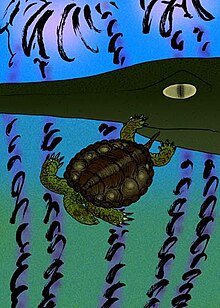
Pentaceratops is a genus of herbivorous ceratopsid dinosaur from the late Cretaceous Period of what is now North America. Fossils of this animal were first discovered in 1921, but the genus was named in 1923 when its type species, Pentaceratops sternbergii, was described. Pentaceratops lived around 76–73 million years ago, its remains having been mostly found in the Kirtland Formation in the San Juan Basin in New Mexico. About a dozen skulls and skeletons have been uncovered, so anatomical understanding of Pentaceratops is fairly complete. One exceptionally large specimen later became its own genus, Titanoceratops, due to its more derived morphology, similarities to Triceratops, and lack of unique characteristics shared with Pentaceratops.

Gryposaurus was a genus of duckbilled dinosaur that lived about 80 to 75 million years ago, in the Late Cretaceous of North America. Named species of Gryposaurus are known from the Dinosaur Park Formation in Alberta, Canada, and two formations in the United States: the Lower Two Medicine Formation in Montana and the Kaiparowits Formation of Utah. A possible additional species from the Javelina Formation in Texas may extend the temporal range of the genus to 66 million years ago.
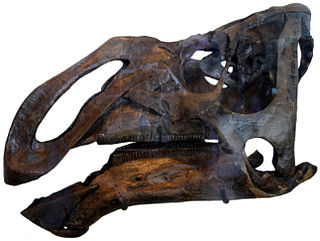
Kritosaurus is an incompletely known genus of hadrosaurid (duck-billed) dinosaur. It lived about 74.5-66 million years ago, in the Late Cretaceous of North America. The name means "separated lizard", but is often mistranslated as "noble lizard" in reference to the presumed "Roman nose".

Sphaerotholus is a genus of pachycephalosaurid dinosaur from the Upper Cretaceous of the western United States and Canada. To date, five species have been described: the type species, S. goodwini, from the Den-na-zin Member of the Kirtland Formation of San Juan County, New Mexico, USA; S. buchholtzae, from the Hell Creek Formation of western Carter County, Montana, USA and the Frenchman Formation of Saskatchewan, Canada; S. edmontonensis, from the Horseshoe Canyon Formation of Alberta, Canada; S. lyonsi, from the Dinosaur Park Formation (Campanian) of Alberta, Canada; and S. triregnum from the Hell Creek Formation of Garfield County, Montana, USA.
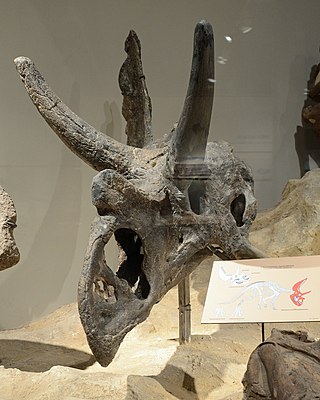
Agujaceratops is a genus of horned dinosaur from the Late Cretaceous (Campanian) of west Texas. It is a chasmosaurine (long-frilled) ceratopsian. Two species are known, Agujaceratops mariscalensis, and A. mavericus.
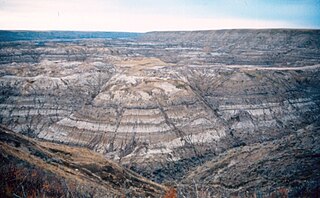
The Horseshoe Canyon Formation is a stratigraphic unit of the Western Canada Sedimentary Basin in southwestern Alberta. It takes its name from Horseshoe Canyon, an area of badlands near Drumheller.

Goniopholididae is an extinct family of moderate-sized semi-aquatic neosuchian crocodyliformes. Their bodyplan and morphology are convergent on living crocodilians. They lived across Laurasia between the Middle Jurassic and the Late Cretaceous.
Terlinguachelys fischbecki is an extinct sea turtle that existed during the Late Cretaceous period some 80 million years ago. It is the sole species in the genus Terlinguachelys and is classified in the family Protostegidae along with other extinct marine turtles.

The Aguja Formation is a geological formation in North America, exposed in Texas, United States and Chihuahua and Coahuila in Mexico, whose strata date back to the Late Cretaceous. Dinosaur remains are among the fossils that have been recovered from the formation. Fossil palms have also been unearthed here.

The Javelina Formation is a geological formation in Texas. Dating has shown that the strata date to the Maastrichtian stage of the Late Cretaceous, approximately 70 to 66.5 million years old. The middle part of the formation has been dated to about 69 million years ago plus or minus 1 million years and the top situated near the Cretaceous–Paleogene boundary, dated to 66 Ma ago. Dinosaur remains are among the fossils that have been recovered from the formation.

Angulomastacator is a genus of duck-billed dinosaur from the Campanian-age Aguja Formation of Big Bend National Park, Texas. It is known from a single specimen, TMM 43681–1, a partial left maxilla. This bone is curved down approximately 45° at its anterior end, with the tooth row bent to fit, unlike any other hadrosaur. The unusual characteristics of the maxilla, which have not been reported from elsewhere, supports the hypothesis that the dinosaurs of the Aguja Formation were endemic forms. It was discovered in the upper shale member of the Aguja Formation, among plant, bone, and clam fragments in a bed interpreted as the deposits of a small tributary channel. This bed is just below rocks of the overlying Javelina Formation. Volcanic rocks at about the same level have been dated to 76.9 ± 1.2 million years ago.

Onchopristis is an extinct genus of sclerorhynchoid from the Cretaceous of North Africa, Europe, and North America. Its name is derived from the Ancient Greek ónkos and prístis. It contains two valid species, O. numida and O. dunklei, though some researchers argue that both may be considered a single taxon with variation in morphology caused by a wide geographical range. Specimens of Onchopristis have been discovered in coastal and fluvial deposits dated from the Barremian to the Cenomanian age, making this genus one of the oldest and longest-lived sclerorhynchoid genera.
Bravoceratops is a genus of large chasmosaurine ceratopsid dinosaur that lived approximately 70 million years ago, and is known from the Late Cretaceous Javelina Formation in what is now Texas, United States.

The Olmos Formation is a geologic formation in Mexico. It preserves fossils of plants, hadrosaurs, ceratopsians, tyrannosaurs and the turtle Palauchelys montellanoi dating back to the Cretaceous period.
Dryadissector is an extinct genus of varanoid lizard represented by the type species Dryadissector shilleri from the Late Cretaceous of Texas. Dryadissector is known only from isolated teeth, which may have been shed by living individuals. These teeth are common in early Campanian strata within the Aguja Formation, which date back about 80 to 82 million years. The teeth of Dryadissector are extremely similar to those of theropod dinosaurs, which led to them initially being misidentified as the remains of theropods. Like theropod teeth, the teeth of Dryadissector are recurved, laterally compressed, and serrated. However, their lizard affinities are made evident by serrations that are smaller and more numerous than those of theropods, as well as a bulge on the inner surface of the base of each tooth that is characteristic of varanoids.
Catactegenys is an extinct genus of xantusiid lizard from the Late Cretaceous of Texas. The type species, Catactegenys solaster, was named in 2013 from the late-Campanian-age Aguja Formation in Brewster County. The genus name means "breaker jaw" in Greek, a reference to its inferred ability to break hard shells with its jaws as an adaptation for a durophagous diet, and the species name means "lone star", a reference to Texas, the "lone star state". Catactegenys is known only from jaw bones, but the size of these bones indicates that it was larger than all other known xantusiids. The teeth are robust and heavily worn, suggesting that Catactegenys may have eaten hard-shelled molluscs, which are common in the Aguja Formation.

Yehuecauhceratops is a genus of horned centrosaurine ceratopsid dinosaur from the Late Cretaceous of Coahuila, Mexico. It contains a single species, Y. mudei, described from two partial specimens by Rivera-Sylva et al. in 2016 and formally named by Rivera-Sylva et al. in 2017. It was a small centrosaurine with a body length of 3 metres (9.8 ft), making it smaller than Agujaceratops and Coahuilaceratops, the other two ceratopsids in its environment; the three may have been ecologically segregated. A ridge bearing a single roughened projection near the bottom of the squamosal bone, which probably supported a small horn, allows Yehuecauhceratops to be distinguished from other centrosaurines. Its affinities to nasutoceratopsin centrosaurines, such as Avaceratops and Nasutoceratops, are supported by various morphological similarities to the former.
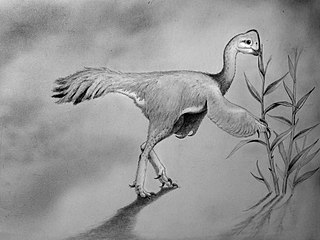
Leptorhynchos is an extinct genus of caenagnathid theropod from the Late Cretaceous of what is now the US state of Texas, although it has been suggested to also exist in Alberta and South Dakota. The type species is L. gaddisi, and it is currently the only widely accepted valid species. The generic name of Leptorhynchos comes from the Greek "leptos" meaning "small" and "rhynchos" meaning "beak". The specific epithet is in honor of the Gaddis family, who owned the land on which the holotype was discovered.

Aquilarhinus is a genus of hadrosaurid ornithopod dinosaur from the Aguja Formation from Texas in the United States. The type and only species is Aquilarhinus palimentus. Due to its unusual dentary, it has been inferred to have had shovel-like beak morphology, different from the beaks of other hadrosaurs. It was originally classified as a Kritosaurus sp. before being reclassified as a new genus in 2019.

Malefica is a genus of hadrosaurid dinosaur from the Late Cretaceous (Campanian) Aguja Formation of Texas. The type and only species is Malefica deckerti.
